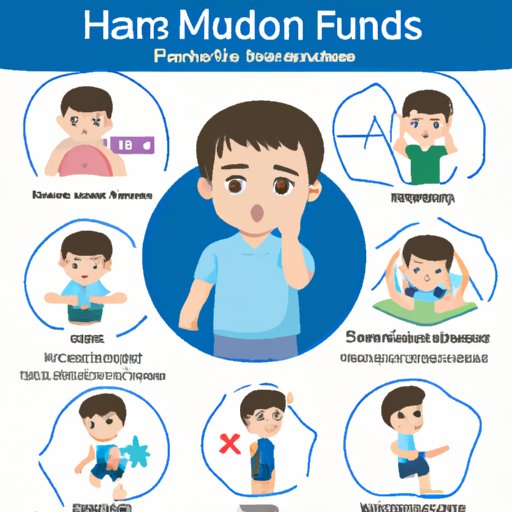Introduction
Hand Foot and Mouth (HFMD) is a viral infection that commonly affects infants and children. It is named after the blisters that typically form on the hands, feet, and mouth of those infected with the virus. HFMD is caused by several types of enteroviruses, usually Coxsackievirus A16 and Enterovirus 71, and can be spread from one person to another. It is essential to understand the contagious period, an important factor in treating and preventing the spread of HFMD.
The Science of Hand Foot and Mouth: Understand the Contagious Period
HFMD typically begins with a sore throat, fever, reduced appetite, and general malaise. After a few days, small, blister-like sores appear on the hands, feet, and mouth. In some cases, rashes may also appear on the buttocks and other parts of the body.
The virus can spread through close contact with an infected person’s saliva, nasal mucus, or feces. It can spread through coughing, sneezing, or contact with contaminated surfaces. The contagious period for HFMD lasts from the time of infection until the last blister has healed.
Several factors influence the length of the contagious period, including the severity of the illness, the age and immune system health of the infected person, and the type of enterovirus causing the infection. Generally, the contagious period for HFMD lasts for about 7-10 days into the illness.
When it comes to returning to school or work, it is safe to do so only if there is no fever, no new blisters during the last 24 hours, and all blisters have scabbed over. It is crucial to inform the school or workplace of the infection to take appropriate precautions.
Signs that Indicate You Are No Longer Contagious with Hand Foot and Mouth
The different stages of HFMD typically last for about a week, although some may experience the side effects for up to ten days. Initially, symptoms begin with fever, headache, and body ache, which could last for 2-3 days. This is then followed by painful sores on the inside of the mouth, then fingers, toes, and other parts of the body. Eventually, the sores will dry out and scab over, indicating the end of the contagious period.
One may assume that they are no longer contagious at the end of the fever or once the sores begin to heal. However, the risk of spreading the virus persists until the last blister has scabbed over. Once all new blisters stop appearing, and the older ones have scabbed over, one is no longer contagious.
It is still important to practice good hygiene to prevent the spread of the virus while recovering, such as washing your hands frequently, not sharing utensils, and disinfecting surfaces regularly.
Prevent the Spread of Hand Foot and Mouth with These Simple Measures
The most critical step in preventing the spread of HFMD is good hygiene practices. Simple actions like frequently washing your hands, avoiding close contact with infected people, and disinfecting surfaces can help limit the transmission of the virus.
To reduce the risk of transmitting the virus through surfaces, disinfect frequently touched surfaces like doorknobs, shared toys, and kitchen counters with a bleach solution. Choose a bleach solution that contains at least 1000 ppm sodium hypochlorite, and let it sit for at least five minutes before wiping it down.
What You Need To Know About The Contagious Period of Hand Foot and Mouth in Children
When it comes to HFMD in children, symptoms may be more severe than in adults. Children may experience a high fever, irritability, and poor appetite in addition to the typical symptoms of HFMD.
Children are often excluded from childcare or school until they have completed their contagious period. It is safe for children who have gone at least 24 hours without a fever and new blister formation, and all blisters have scabbed over to return to school. However, improved hygiene practices are necessary to prevent a recurrence of the infection.
Parents and caregivers can protect young ones from HFMD by taking simple preventive measures such as monitoring their child’s handwashing practices, using sanitizer or disinfectant wipes before playground or any group activities, and watching out for any symptoms of HFMD.
Conclusion
HFMD can be a challenging illness, but understanding the contagious period and taking preventive measures can vastly reduce the risk of infection and spread. Keeping hands clean, disinfecting surfaces regularly, and monitoring symptoms can go a long way in preventing further spread. Staying informed about the stages and the contagious period of HFMD can make all the difference in preventing the spread among children and adults.
